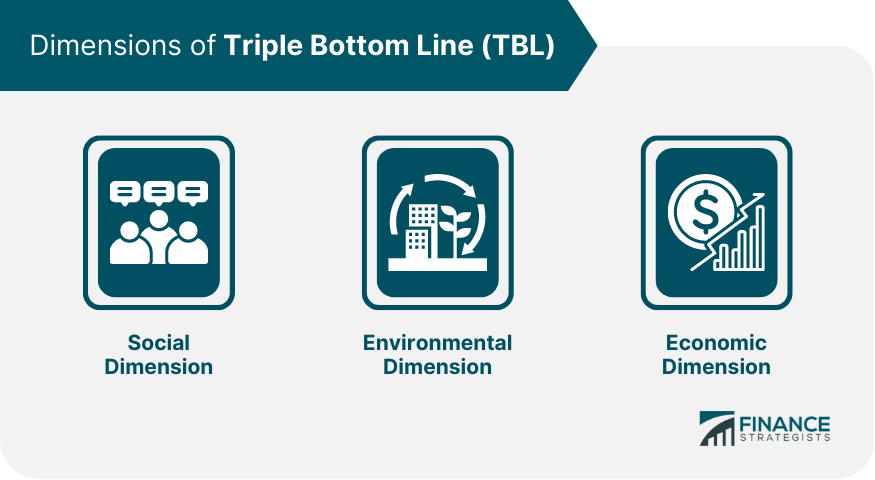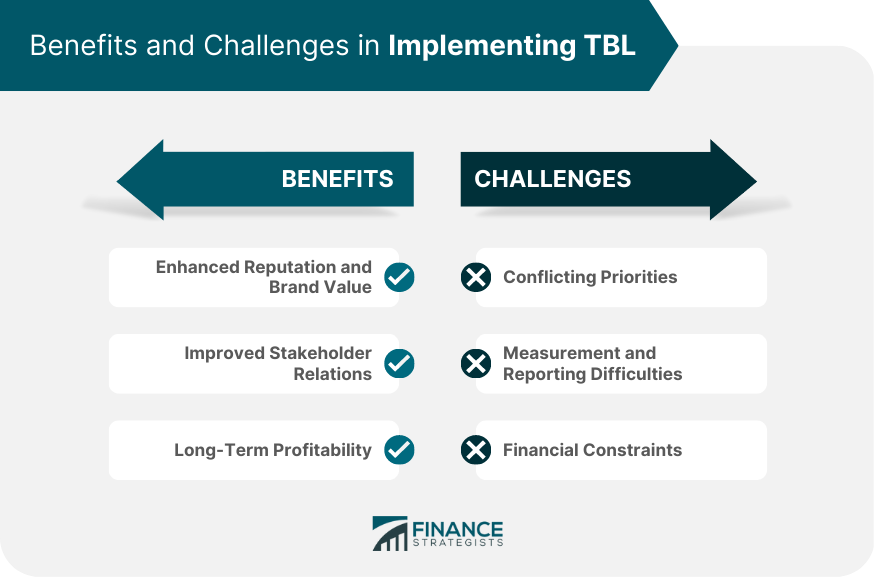What Is Triple Bottom Line (TBL)?
Triple Bottom Line (TBL) is a framework that emphasizes that businesses should not only focus on financial profitability but also prioritize social and environmental responsibility.
TBL considers the impact of an organization's operations on three dimensions of sustainability: social, environmental, and economical.
The concept of Triple Bottom Line is gaining more prominence in the business world as organizations strive to implement more sustainable practices.
Social Dimension of TBL
The social dimension of TBL refers to an organization's operations' impact on its stakeholders, including employees, customers, communities, and society as a whole.
Social responsibility is an integral part of TBL as it emphasizes that businesses should operate in a way that promotes the well-being of these stakeholders.
Examples of social impact can include creating jobs in the community, providing fair wages and benefits to employees, investing in employee training and development, and supporting local initiatives.
Additionally, businesses can demonstrate social responsibility by promoting diversity, equity, and inclusion and engaging in philanthropic activities supporting social causes.
Businesses should recognize that social responsibility is not just a matter of goodwill but a fundamental component of their operations.
Prioritizing social responsibility can lead to increased employee morale and loyalty, improved customer relations, and enhanced brand reputation.
Environmental Dimension of TBL
The environmental dimension of TBL refers to an organization's operations' impact on the natural environment.
Environmental responsibility is critical in TBL as it recognizes that businesses have a responsibility to operate in a way that minimizes harm to the environment.
Examples of environmental impact can include reducing greenhouse gas emissions, minimizing waste and pollution, conserving natural resources, and supporting the use of renewable energy.
Additionally, businesses can demonstrate environmental responsibility by implementing sustainable practices in their operations, such as using eco-friendly materials, reducing water usage, and promoting sustainable transportation.
Businesses should recognize that environmental responsibility is not just a matter of compliance with regulations but a crucial component of their operations.
Prioritizing environmental responsibility can lead to reduced operating costs, improved environmental health, and enhanced reputation among environmentally conscious customers.
Economic Dimension of TBL
The economic dimension of TBL refers to the impact that an organization's operations have on the financial well-being of the organization and its stakeholders.
Economic responsibility is critical in TBL as it recognizes that businesses are responsible for operating in a way that promotes long-term financial sustainability.
Examples of economic impact can include generating revenue, providing economic opportunities, and creating jobs.
Additionally, businesses can demonstrate economic responsibility by promoting ethical business practices, investing in employee development, and supporting local economic development initiatives.
Importantly, businesses should recognize that economic responsibility is not just a matter of maximizing profits but rather a crucial component of their operations.
Prioritizing economic responsibility can increase customer loyalty, improve employee satisfaction, and enhance long-term profitability.

Benefits of TBL
Implementing TBL can provide several benefits for businesses, including enhanced reputation and brand value, improved stakeholder relations, and long-term profitability.
Enhanced Reputation and Brand Value
Implementing TBL can enhance a business's reputation and brand value by demonstrating a social and environmental responsibility commitment.
Customers are increasingly conscious of businesses' impact on society and the environment and are more likely to support businesses that prioritize sustainability.
Improved Stakeholder Relations
Implementing TBL can improve stakeholder relations by demonstrating a commitment to the well-being of employees, customers, and communities.
This can lead to increased employee loyalty, improved customer satisfaction, and enhanced relations with local communities.
Long-Term Profitability
Implementing TBL can lead to long-term profitability by promoting sustainable practices that reduce costs, increase efficiency, and enhance customer loyalty.
Businesses prioritizing sustainability can also benefit from access to new markets and investment opportunities, which can help drive long-term growth.
Challenges in Implementing TBL
Implementing TBL is not challenging, and businesses must navigate several obstacles to implement sustainable practices successfully.
Conflicting Priorities
Businesses must balance the competing demands of social, environmental, and economic responsibilities, which can be challenging given the trade-offs that often exist between these dimensions.
For example, implementing sustainable practices may require significant investments that may impact short-term profitability.
Measurement and Reporting Difficulties
Measuring and reporting the impact of sustainable practices can be challenging due to the complexity and interdependence of social, environmental, and economic factors.
Businesses must develop robust measurement and reporting frameworks to ensure that they can accurately capture the impact of their operations on each dimension of sustainability.
Financial Constraints
Implementing sustainable practices can be costly, particularly for small and medium-sized enterprises (SMEs) with limited financial resources.
Businesses must carefully balance the costs and benefits of sustainable practices to ensure that they can implement sustainable practices that are financially viable.

TBL Frameworks and Tools
Several frameworks and tools can help businesses to implement TBL and promote sustainable practices.
Global Reporting Initiative (GRI): GRI is a widely recognized framework for sustainability reporting that provides a standardized approach to measuring and reporting the impact of business operations on social, environmental, and economic dimensions of sustainability.
Sustainability Accounting Standards Board (SASB): SASB provides industry-specific sustainability standards that help businesses to identify and report on the sustainability issues that are most relevant to their operations.
Integrated Reporting (IR): IR is a framework for reporting that emphasizes the interdependence of social, environmental, and economic factors and seeks to provide a comprehensive view of a business's impact on sustainability.
Conclusion
Triple Bottom Line is a critical framework for promoting sustainable business practices prioritizing social, environmental, and economic responsibility.
By implementing TBL, businesses can reap benefits such as enhanced reputation and brand value, improved stakeholder relations, and long-term profitability.
However, implementing TBL can be challenging, and businesses must carefully navigate the competing demands of social, environmental, and economic responsibility.
To ensure the successful implementation of sustainable practices, businesses can utilize TBL frameworks and tools such as the Global Reporting Initiative, the Sustainability Accounting Standards Board, and Integrated Reporting.
Given the complexity of implementing TBL and its potential benefits, it may be beneficial for businesses to consider hiring a financial advisor who specializes in wealth management.
By hiring a financial advisor, businesses can enhance their chances of successfully implementing sustainable practices prioritizing social, environmental, and economic responsibility, leading to long-term profitability and a positive impact on society and the environment.
Triple Bottom Line (TBL) FAQs
Triple Bottom Line (TBL) is a framework that emphasizes that businesses should not only focus on financial profitability but also prioritize social and environmental responsibility. TBL considers the impact of an organization's operations on three dimensions of sustainability: social, environmental, and economic.
Implementing TBL can provide several advantages for businesses, including enhanced reputation and brand value, improved stakeholder relations, and long-term profitability. By prioritizing sustainability, businesses can also benefit from access to new markets and investment opportunities, which can help to drive long-term growth.
Implementing TBL is relatively easy, and businesses must navigate several obstacles to implement sustainable practices successfully. These challenges include conflicting priorities, measurement and reporting difficulties, and financial constraints.
Several frameworks and tools can help businesses to implement TBL and measure their impact on sustainability. These include the Global Reporting Initiative (GRI), the Sustainability Accounting Standards Board (SASB), and Integrated Reporting (IR).
A financial advisor can guide how to effectively implement TBL and navigate the various challenges that businesses may face. By hiring a financial advisor, businesses can enhance their chances of successfully implementing sustainable practices prioritizing social, environmental, and economic responsibility, leading to long-term profitability and a positive impact on society and the environment.
True Tamplin is a published author, public speaker, CEO of UpDigital, and founder of Finance Strategists.
True is a Certified Educator in Personal Finance (CEPF®), author of The Handy Financial Ratios Guide, a member of the Society for Advancing Business Editing and Writing, contributes to his financial education site, Finance Strategists, and has spoken to various financial communities such as the CFA Institute, as well as university students like his Alma mater, Biola University, where he received a bachelor of science in business and data analytics.
To learn more about True, visit his personal website or view his author profiles on Amazon, Nasdaq and Forbes.











